| dc.contributor.author | Митрофанов, А. В. | |
| dc.contributor.author | Мизонов, В. Е. | |
| dc.contributor.author | Шпейнова, Н. С. | |
| dc.contributor.author | Василевич, С. В. | |
| dc.contributor.author | Касаткина, Н. К. | |
| dc.coverage.spatial | Минск | ru |
| dc.date.accessioned | 2021-07-22T12:03:55Z | |
| dc.date.available | 2021-07-22T12:03:55Z | |
| dc.date.issued | 2021 | |
| dc.identifier.citation | Опытно-теоретическое исследование аксиального распределения частиц твердой фазы в кипящем слое = Experimental and Theoretical Study of the Axial Distribution of Solid Phase Particles in a Fluidized Bed / А. В. Митрофанов [и др.] // Энергетика. Известия высших учебных заведений и энергетических объединений СНГ. – 2021. – № 4. – С. 349-362. | ru |
| dc.identifier.uri | https://rep.bntu.by/handle/data/97757 | |
| dc.description.abstract | В статье представлены результаты расчетных и экспериментальных исследований распределения модельного материала (пластмассовых сферических частиц размером 6 мм) по высоте лабораторного двумерного аппарата кипящего слоя периодического принципа действия. Для экспериментального определения распределения твердой фазы по высоте аппарата выполнены цифровые фотографии кипящего слоя, которые затем анализировались при помощи специально разработанного для этого алгоритма. Алгоритм подразумевал разбиение изображения по высоте на отдельные прямоугольные области, идентификацию частиц и подсчет их числа в каждой из указанных областей. Численные эксперименты выполнялись с использованием предложенной ранее одномерной ячеечной модели процесса псевдоожижения, построенной на основе математического аппарата теории счетных цепей Маркова с дискретным пространством и временем. Расчетная схема модели предполагает пространственную декомпозицию слоя по высоте на отдельные элементы малых конечных размеров. Таким образом, получаемые численно результаты в качественном отношении отвечают поставленному натурному эксперименту. Для обеспечения количественной достоверности расчетных прогнозов выполнена параметрическая идентификация модели с привлечением известных эмпирических зависимостей для расчета коэффициента сопротивления частиц и оценки коэффициента их макродиффузии. Сравнение результатов численных и натурных экспериментов позволило выделить наиболее продуктивные эмпирические соотношения, сочетающиеся с ячеечной схемой моделирования процесса. Полученная физико-математическая модель обладает высокой прогностической эффективностью и может использоваться для инженерных расчетов аппаратов с кипящим слоем, а также для постановки и решения задач оптимального управления технологическими процессами в этих аппаратах по различным целевым функциям. | ru |
| dc.language.iso | ru | ru |
| dc.publisher | БНТУ | ru |
| dc.title | Опытно-теоретическое исследование аксиального распределения частиц твердой фазы в кипящем слое | ru |
| dc.title.alternative | Experimental and Theoretical Study of the Axial Distribution of Solid Phase Particles in a Fluidized Bed | ru |
| dc.type | Article | ru |
| dc.identifier.doi | 10.21122/1029-7448-2021-64-4-349-362 | |
| local.description.annotation | The article presents the results of computational and experimental studies of the distribution of a model material (plastic spherical particles with a size of 6 mm) along the height of a laboratory two-dimensional apparatus of the fluidized bed of the periodic principle of action. To experimentally determine the distribution of the solid phase over the height of the apparatus, digital photographs of the fluidized bed were taken, which were then analyzed using an algorithm that had been specially developed for this purpose. The algorithm involved splitting the image by height into separate rectangular areas, identifying the particles and counting their number in each of these areas. Numerical experiments were performed using the previously proposed one-dimensional cell model of the fluidization process, constructed on the basis of the mathematical apparatus of the theory of Markov chains with discrete space and time. The design scheme of the model assumes the spatial decomposition of the layer in height into individual elements of small finite sizes. Thus, the numerically obtained results qualitatively corresponded to the full-scale field experiment that had been set up. To ensure the quantitative reliability of the calculated forecasts, a parametric identification of the model was performed using known empirical dependencies to calculate the particle resistance coefficient and estimate the coefficient of their macrodiffusion. A comparison of the results of numerical and field experiments made us possible to identify the most productive empirical dependencies that correspond to the cellular scheme of modeling the process. The resulting physical and mathematical model has a high predictive efficiency and can be used for engineering calculations of devices with a fluidized bed, as well as for setting and solving problems of optimal control of technological processes in these devices for various target functions. | ru |

